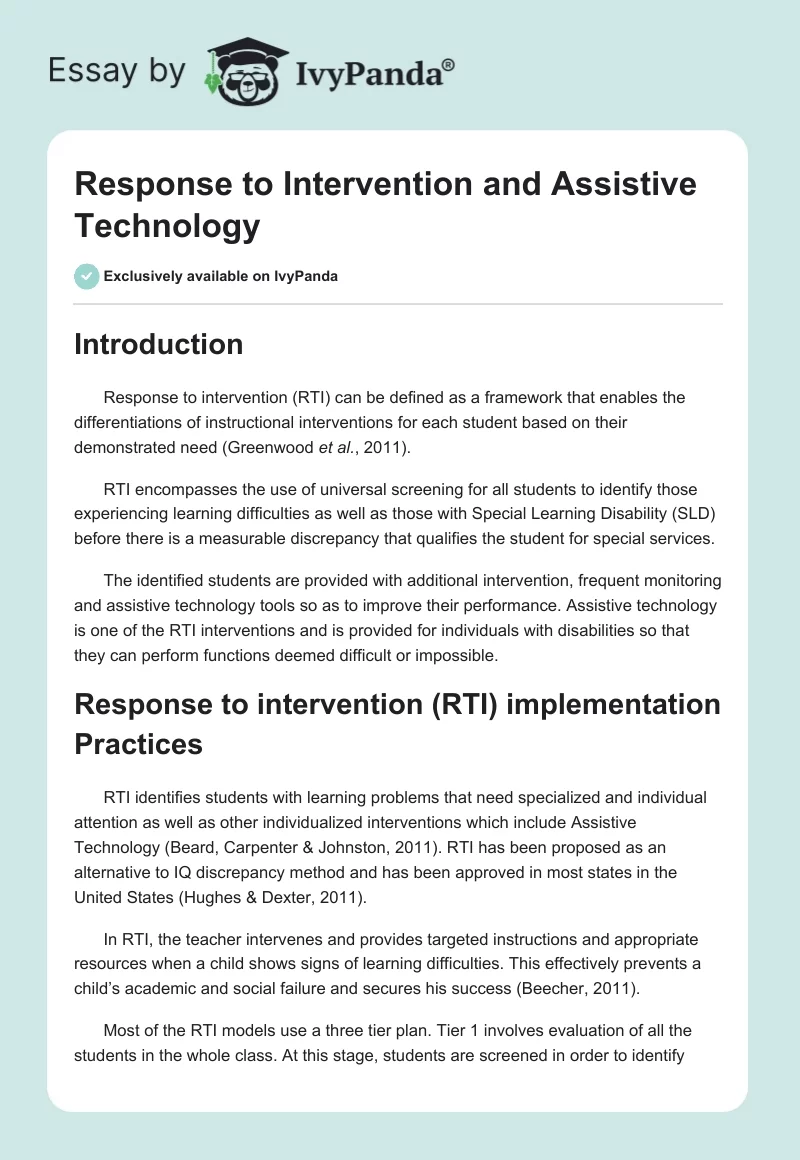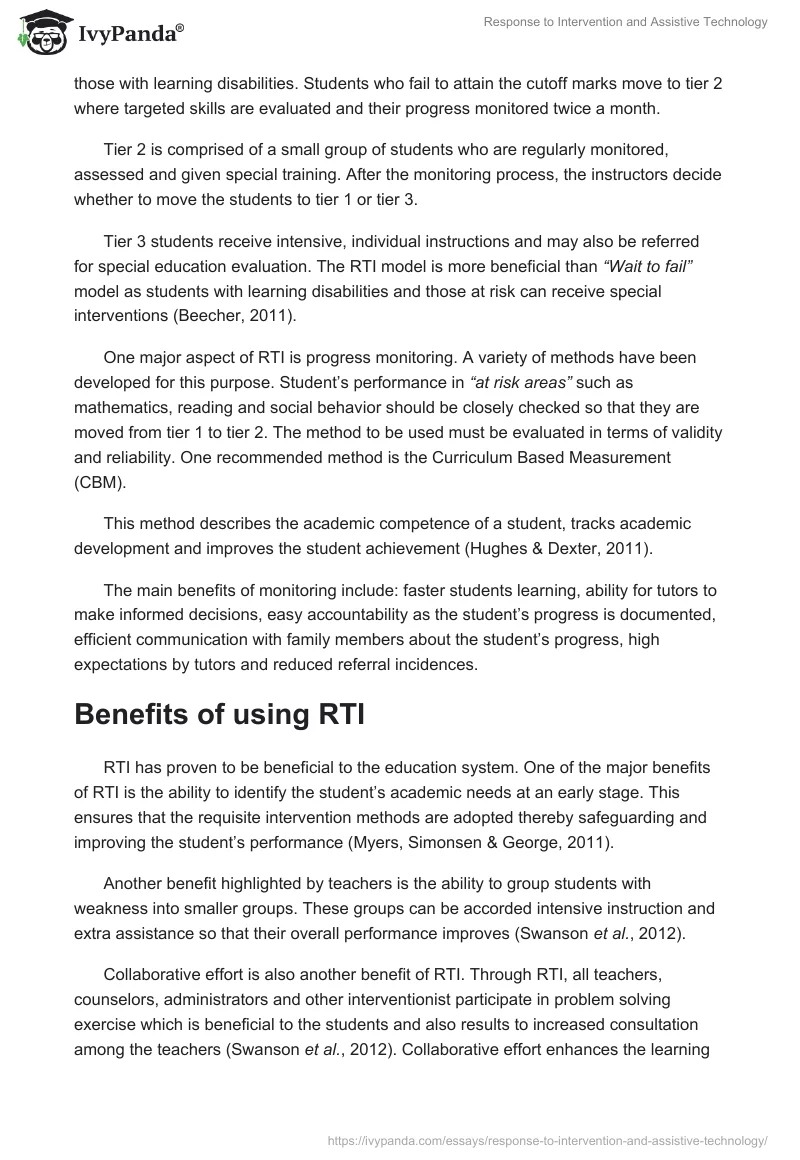Introduction
Response to intervention (RTI) can be defined as a framework that enables the differentiations of instructional interventions for each student based on their demonstrated need (Greenwood et al., 2011).
RTI encompasses the use of universal screening for all students to identify those experiencing learning difficulties as well as those with Special Learning Disability (SLD) before there is a measurable discrepancy that qualifies the student for special services.
The identified students are provided with additional intervention, frequent monitoring and assistive technology tools so as to improve their performance. Assistive technology is one of the RTI interventions and is provided for individuals with disabilities so that they can perform functions deemed difficult or impossible.
Response to intervention (RTI) implementation Practices
RTI identifies students with learning problems that need specialized and individual attention as well as other individualized interventions which include Assistive Technology (Beard, Carpenter & Johnston, 2011). RTI has been proposed as an alternative to IQ discrepancy method and has been approved in most states in the United States (Hughes & Dexter, 2011).
In RTI, the teacher intervenes and provides targeted instructions and appropriate resources when a child shows signs of learning difficulties. This effectively prevents a child’s academic and social failure and secures his success (Beecher, 2011).
Most of the RTI models use a three tier plan. Tier 1 involves evaluation of all the students in the whole class. At this stage, students are screened in order to identify those with learning disabilities. Students who fail to attain the cutoff marks move to tier 2 where targeted skills are evaluated and their progress monitored twice a month.
Tier 2 is comprised of a small group of students who are regularly monitored, assessed and given special training. After the monitoring process, the instructors decide whether to move the students to tier 1 or tier 3.
Tier 3 students receive intensive, individual instructions and may also be referred for special education evaluation. The RTI model is more beneficial than “Wait to fail” model as students with learning disabilities and those at risk can receive special interventions (Beecher, 2011).
One major aspect of RTI is progress monitoring. A variety of methods have been developed for this purpose. Student’s performance in “at risk areas” such as mathematics, reading and social behavior should be closely checked so that they are moved from tier 1 to tier 2. The method to be used must be evaluated in terms of validity and reliability. One recommended method is the Curriculum Based Measurement (CBM).
This method describes the academic competence of a student, tracks academic development and improves the student achievement (Hughes & Dexter, 2011).
The main benefits of monitoring include: faster students learning, ability for tutors to make informed decisions, easy accountability as the student’s progress is documented, efficient communication with family members about the student’s progress, high expectations by tutors and reduced referral incidences.
Benefits of using RTI
RTI has proven to be beneficial to the education system. One of the major benefits of RTI is the ability to identify the student’s academic needs at an early stage. This ensures that the requisite intervention methods are adopted thereby safeguarding and improving the student’s performance (Myers, Simonsen & George, 2011).
Another benefit highlighted by teachers is the ability to group students with weakness into smaller groups. These groups can be accorded intensive instruction and extra assistance so that their overall performance improves (Swanson et al., 2012).
Collaborative effort is also another benefit of RTI. Through RTI, all teachers, counselors, administrators and other interventionist participate in problem solving exercise which is beneficial to the students and also results to increased consultation among the teachers (Swanson et al., 2012). Collaborative effort enhances the learning process and ensures that appropriate instructions are accorded to tier 2 and tier 3 students.
RTI has also been found to reduce the number of students being referred for special education. The use of RTI showed a 38% decline in the number of students referred for special education at preschool level. Though interventions, student’s experiencing learning difficulties can be specially trained thereby preventing their referral to special education (Greenwood et al., 2012).
RTI Problems and Challenges
The implementation of RTI poses many challenges. There is no criterion that has been developed to aid in identifying students at risk in tier 1 screening (Hughes & Dexter, 2011). Some tutors use the percentile method so as to identify students performing below average.
However, this method has been criticized as there will always be students in the lowest quartile, that is, students may be ranked last in a class but this does not necessary mean that they have difficulties. This presents a problem in the identification of students at risk and makes screening exceptionally difficult.
Another impediment to RTI is lack of knowledge and resources. Teachers lack the knowledge on how to differentiate the different levels of instructions that students may need.
This can be alleviated through appropriate training so that tutors can conceptualize on ways of meeting the student’s educational needs (Greenwood et al., 2011). Other challenges include: workforce quality, lack of appropriate intervention strategies, lack of progress monitoring tools and poor administrative resources.
Use of Assistive Technology (AT) in RTI
Assistive technology encompasses the different services and equipments that are used by individuals with disability so as to enable them perform functions that are deemed impossible. AT devices and services are used to increase and improve the functional capabilities of students with disabilities.
AT differs from universal design for learning (UDL) in that; while UDL involves the development of products and services that can be used by a wide range of users, AT devices are specific and the products developed are used to enhance the learning ability of disabled students.
RTI works in conjunction with AT. The RTI process identifies students with special needs that prevent them from using UDL devices. These students are availed AT equipments to improve their performance. Thus, RTI assist in the identification of struggling students while AT provides some remedial measures to students facing difficulties.
Neglecting the use of RTI can result to serious negative consequences. Universal screening is necessary so as to identify students with academic difficulties so that extra attention is given to them. When this is not done, the student’s academic performance may drop and result to eventual failure. RTI is designed as an effective service delivery tool through which effective training can be accorded to academically poor students.
Providing intervention at an early childhood level provides important social, emotional and literacy experiences which prevent the need for special education. Without early intervention: poor literacy, behavioral disorders and language problem may result (Greenwood et al., 2011).
One of the main RTI process is effective monitoring of students. When this is not done, the teacher may fail to identify the declining student performance and this eventually increases the number of students recommended for special education.
Neglecting the use of RTI especially in disabled children can result to drastic problems. RTI evaluations effectively identify students with difficulties while using UDLs and recommend the use of AT. When this is not performed, the students may have difficulties during study and this result to eventual failure.
References
Beard, L.A., Carpenter, L.B., & Johnston, L.B. (2011). Assistive technology:
Access for all students (2nd ed.). Upper Saddle River, NJ: Pearson Education, Inc.
Beecher, C.C. (2011). Response to Intervention: A socio-cultural perspective of the problems and the possibilities. Journal of education,191(3),1-8.
Greenwood, C.R., Bradfield, T., Kaminski, R., Linas, M., Carta, J., & Nylander, D. (2011).The response to intervention RTI approach in early childhood. Focus on exceptional children, 43(9),1-23.
Hughes, C. & Dexter, D. (2011). Response to Intervention: A Research-Based Summary. Current Perspectives on Learning Disabilities and ADHD, 50(1), 4–11.
Myers, D. M., Simonsen, B., & George, S. (2011). Increasing Teachers’ Use of Praise with a Response-to-Intervention Approach. Education and Treatment of Children,34(1).
Swanson,E., Solis, M., Ciullo, S. & Mckenna , J. (2012). Special Education Teachers’ Perceptions and Instructional Practices in Response to Intervention Implementation. Learning Disability Quarterly, 35(2),115–126.


